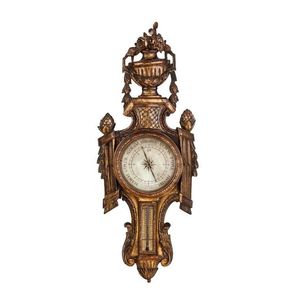French Giltwood Barometer with Eagle and Cornucopia
You must be a subscriber, and be logged in to view price and dealer details.
Subscribe Now to view actual auction price for this item
When you subscribe, you have the option of setting the currency in which to display prices to $Au, $US, $NZ or Stg.
- Cornucopia - The cornucopia, literally the horn of plenty, is a symbol of abundance and wealth. It is traditionally is represented by a curved goat horn overflowing with grain and fruit.
Modern cornucopias are often depicted as horn-shaped baskets filled with food, and this symbol is often associated with the harvest. This decorative device has a long and ancient history, with roots in Greek mythology.
In one version, when Zeus was playing with the goat Amalthea he accidentally broke off one of her horns. To atone for this, Zeus promised Amalthea that the horn would always be full of whatever fruits she desired. This became the cornucopia of the Roman goddess Copia, the personification of plenty. Other goddesses, including Fortuna and Pax, also held the cornucopia.
In furniture and decorative arts, cornucopia as a decorative element have been popular since the 16th century and can be found on items as diverse as light fittings and candelabra to clocks, sculpture and statuary and furniture.
In ceramics, cornucopia shaped vases were popular in the 19th century, in singles and pairs. - Giltwood - Giltwood is used to describe a gold finish on furniture and other decorative wooden items, whereby a thin sheet of gold metal, called gold leaf, is applied to the surface for decorative purposes.
Unlike gilding, where the gold leaf is applied over a coating of gesso, with giltwood the gold leaf is applied direct to the surface, or over a coat of linseed oil gold leaf adhesive.
Most gold-finished mirrors will be gilded, whereas furniture with gold highlights will have the gold applied through the giltwood method.
This item has been included into following indexes:
Visually similar items

A good gilt-wood barometer, French, circa 1780. 105 cm high, 44 cm wide

A good 19th century gilded framed convex wall mirror, the circular frame with ebonised internal moulding, the eagle pediment with outstretched wings upon a rocky outcrop, scroll and leaf detail applied mount to the base. Diameter 65 cm

A bronze cartel clock in the Louis XVI manner 71 cm high

French Prussian blue and ormolu Vasiform clock, c. 1880, the porcelain body surmounted by a floral finial, flanked by satyr heads and mounted with laurel swags, raised on a pedestal base cast with acanthus leaves, 8 day striking movement, the white porcela
